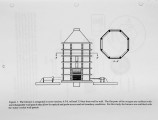| OCR Text |
Show distribution u~ing the trac~r technique is a practical way to estimate the fractions of furnace volume that are effectIvely well-mIxed and in plug flow . The ratio of the residence time in the plug-flow portion of the furnace to the mean residence time was 0.31 at a heat input of 2 MMBtu/h and 25% excess air, so, according to the tracer measurement, the boundary between the well-mixed and plug flows is at roughly 70% of the distance fron1 the burner to the bottom of the furnace exit cone at this condition, higher than suggested by measurements of the radial distributions of gas temperature, velocity and species mole fractions as functions of height. Application of Two-Stage Lagrangian Model Application of the elementary chemical reaction mechanism, including fonnation of air toxic species, being developed by Marinov et al. (1996) to model combustion in the John Zink PDA-12 burner requires a simplified approach to modeling the fluid mechanics. The Two-Stage Lagrangian (TSL) model, originally developed by Broadwell and Breidenthal (1982), provides a simple description of the turbulent mixing in the fuel jets of the burner. Based upon the observed flame structure of the PDA burner, we apply the TSL model twice: first for individual jet flames that exist in the quarl, and again for a merged jet exiting the quarl, as shown schematically in Figure 15. Previously, application of the TSL model to the individual flames in the quarl assumed that the jets entrained and mixed surrounding fluid at a constant rate, as measured in vertical flames in a quiescent ambient gas. In reality, the PDA burner jets are inclined at a 45-degree angle to the vertical flow of air, so the mixing rate is different as shown by the jet imaging work described above. Figure 16 compares the measured decay of seed concentration (circles) to the computed decay of fuel mixture fraction for the constant entrainment rate (dashed curve) using equation (6). To account for the reduced entrainment rate, we modified equation (6) using an exponential tenn, (7) for c = 0.16, B = 0.0204, Xo = 0, andza = 12.95 . The solutions for benzene and toluene in the jet flames in the quarl are shown in Figure 17, comparing the solution for the constant entrainment rate to that with the rate fitted to the observed exponential decay. The jet fluid in this case is refinery fuel gas, approximated by a mixture of methane, hydrogen and propane, with small amounts of ethane, carbon dioxide, and nitrogen. The jet velocity is sonic, with a discharge coefficient of 0.9, which reduces the effective area of the nozzle. The jet mixture entrains the surrounding air as the solution proceeds downstream. Benzene and toluene are produced while the mixture is fuel-rich and hot. As air continues to enter the jet, oxidation consumes these species to levels below the numerical accuracy of the solution - effectively to zero. This suggests there is no lower limit of the species concentration that exists due to chemical kinetic limitations. The effects of the adjusted entrainment rate are to move the fonnation of air toxic species downstream, and to increase the peak concentrations by a factor of about 3. The increased magnitude of the peak mole fractions in the case of slower entrainment (the exponential solution) is 8 |

































